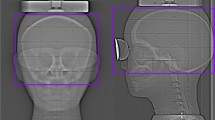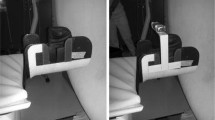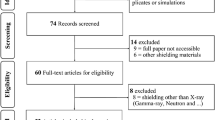Abstract
This study investigated the effect of gantry angulation and eye shielding on radiation dose to the eye lens during brain Computed Tomography (CT), and secondly the effectiveness of thyroid and breast bismuth shielding during routine neck and chest CT. An anthropomorphic ‘Rando’ phantom was scanned at three commonly used gantry angles using this centre’s normal adult brain protocol, and for normal adult neck and chest protocols. Bismuth shields were placed over the appropriate organs and dose measured using thermoluminescent dosimeters (TLD). Angling the gantry along the supra-orbital meatal plane could reduce the dose by approximately 88% relative to the hard palate and Reid’s base line protocols. Bismuth eye shields reduce dose by up to 48% when using either of the first two angles but gave no significant reduction in the supra-orbital plane. Reduction in thyroid dose for neck and chest scans were 55% and 47% respectively, and dose reduction in breast was 23%. We thus conclude that angling the gantry to avoid the orbits is the more effective method of reducing radiation dose to the eyes, with single use bismuth shields to be used where this is not feasible. Thyroid and breast shields should be used where the resultant artefact is not detrimental toimage quality.
Similar content being viewed by others
References
United Nations Scientific Committee on the Effects of Atomic Radiation (UNSCEAR),Sources and effects of Ionising Radiation, 1992.
Barnes, E.,Paediatric CT won’t stop growing but dose can be minimised, Aunt Minnie. 2004.
Hopper, K.D., Nueman J.D., King, S.H. and Kunselman, A.R.,Radioprotection to the eye during CT Scanning, AJNR Am J Nueroradiol. 22.: 1194–1198, 2001.
Thomson, J.E.M. and Tingey, D.R.C.,Radiation dose from Computed tomography in Australia, Australian Radiation Laboratory (ARL/TR). 123, Nov 1997.
Perez, C.A. and Brady, L.W.,Principles and Practice of Radiation Oncology, JB Lippincott, Philadelphia, 1992.
Dalrymple, G.V., Goulden, M.E., Kollmorgen, G.M. and Vogel, H.,Medical Radiation Biology, Philadelphia, W.B. Saunders, p. 235, 1973.
Martin, A. and Harbison, S.,An introduction to radiation protection, London Science Paperbacks, p41, 1972.
Merrican G.R. and Focht, E.F.,A Clinical study of radiation cataracts and the relationship to dose, AJR Am J Roentgenol.: 77, 759–785, 1957.
Committee on the biological effects of ionising radiation. Health effects of exposure to low levels of ionising radiation, Washington DC National Academy, 363, 1990.
Siddle, K.J., Sim, L.H. and Case, C.C.,Radiation doses to the lens of the eye during computerised tomography of the orbit. A comparison of four modern Computerised tomography units, Australas Radiol. 34.: 323–325, 1990.
Yeoman, L.J., Howarth, L., Britten, A., Cotterill, A. and Adam, E.J.,Gantry angulation in Brain CT: Dosage implications effect on posterior fossa artefacts and current international practice, Radiology, 184.: 113–116, 1992.
Wales CT Prince of Wales Hospital, Sydney Normal brain protocol.
Alberico, R.A., Loud, P., Pollina, J., Greco, W., Patel, M. and Klufas, R.,Thick-Section Reformatting of Thinly Collimated Helical CT for Reduction of Skull Base-Related Artefacts, AJR. 175(5).: 1361–6, 2000.
Mostrom, U., Ytterbergh, C. and Bergstrom, K.,Eye lens dose in cranial computed tomography with reference to technical development of CT Scanners, Acta radiol. Diag. 27.: 599–606, 1986.
Nicholoson, R., Fetherton, S.,Primary radiation outside the imaged volume of a Multislice helical CT Scan, BJR British Journal Of Radiology. 75.: 518–522, 2002.
Rozeik, C., Kotterer, O., Preiss, J., Scutz, M., Dingler, W and Deininger, H.K.,Cranial CT artefacts and Gantry Angulation, J. Comp Asst Tomography. 15.: 381–386, 1991.
Protocol for CT Brain imaging Beaumont Hospital Dublin, Ireland, 1998.
McLaughlin, D.J., Mooney, R.B.,Dose reduction to radiosensitive tissues in CT. Do commercially available shields meet the user’s needs?, Clinical Radiology. 59.: 446–450, 2004.
ATX Medical Solutions. (Provider of Attenurad Bismuth Shields) Australia.
Hopper, K.D., King, S.H., Lobell, M.E., TenHave, T.R and Weaver, J.S.,The Breast: In plane X-ray protection during Diagnostic Thoracic CT-Shielding with Bismuth Radioprotective Garments, Radiology. 205.: 853–858, 1997.
Fricke, Bradley L., Donnelly, L.F., Frush, D.P., Yoshizumi, T., Varchena, V., Poe S.A., Lucaya, J.,In plane Bismuth Breast shields for Paediatric CT: effects on Radiation Dose and Image Quality using Experimental and Clinical Data, AJR:. 180, 2003.
http://www.arpansa.gov.au/basics/units.htm. Australian Radiation Protection and Nuclear Safety Agency.
Lewis, M.A. and Edyvean, S.,Patient Dose reduction in CT, BJR. 78.: 880–883, 2005.
Dawson, P.,Patient dose in Multislice CT: Why it is increasing and does it matter?, BJR. 77.: 10–13, 2004.
Author information
Authors and Affiliations
Corresponding author
Rights and permissions
About this article
Cite this article
Heaney, D.E., Norvill, C.A.J. A Comparison of reduction in CT dose through the use of gantry angulations or bismuth shields. Australas. Phys. Eng. Sci. Med. 29, 172–178 (2006). https://doi.org/10.1007/BF03178890
Received:
Accepted:
Issue Date:
DOI: https://doi.org/10.1007/BF03178890




